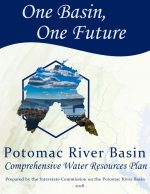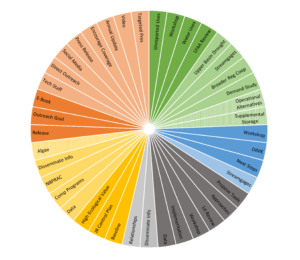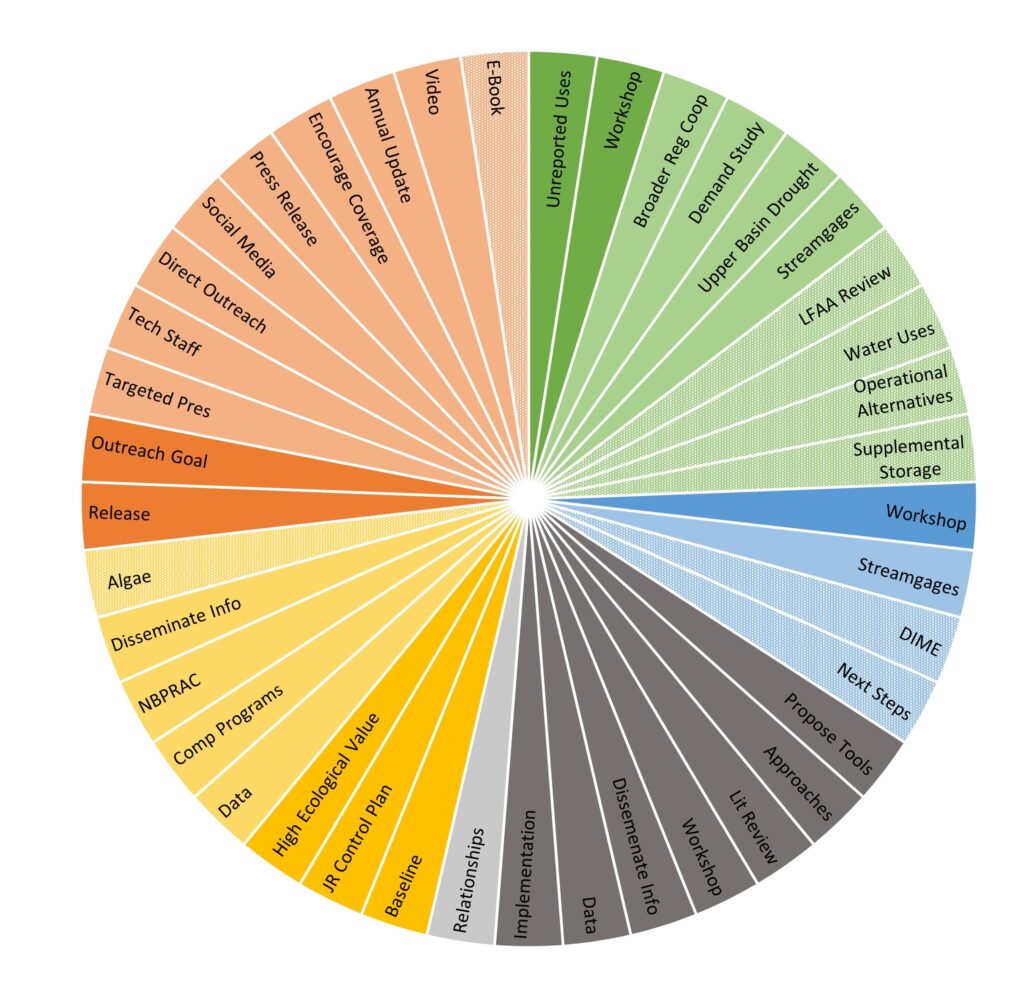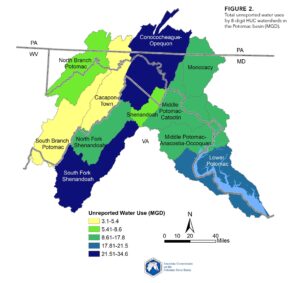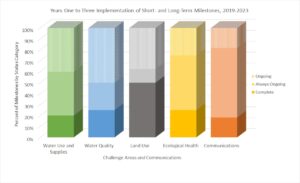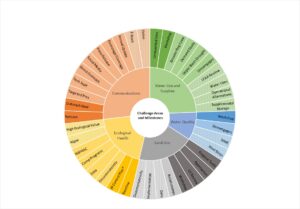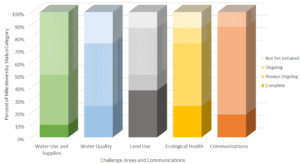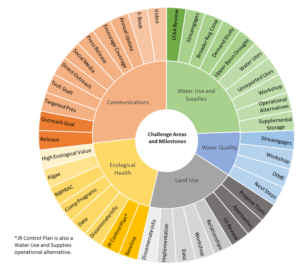Potomac Basin Comprehensive Water Resources Plan
Interstate Commission on the Potomac River Basin
**At the March 12, 2024, ICPRB Quarterly Business Meeting, the ICPRB Commissioners formally adopted the 2023 Updates to the Potomac Basin Comprehensive Water Resources Plan. The 2023 Updates were the result of a yearlong stakeholder process that evaluated progress during the first five years of implementation and articulated the action items for the next five years. Read ICPRB’s News Release to learn more. **
One Basin, One Future
The Potomac Basin Comprehensive Water Resources Plan, adopted by the ICPRB Commissioners in June 2018, is the culmination of a multi-year, collaborative process that engaged diverse stakeholders. The plan describes a shared vision for the basin, identifies water resources issues of interstate and/or basin wide significance, and recommends actions for achieving the shared vision. It is a fifteen year plan that will be reviewed every five years to evaluate implementation progress and identify actions over the next five-year period. There is a role for everyone in the plan’s implementation.
The plan has resulted in a variety of products which can be found in the One Basin, One Future Collection.
Vision
This plan provides a roadmap to achieving our shared vision that the Potomac river basin will serve as a national model for water resources management that fulfills human and ecological needs for current and future generations. The plan will focus on sustainable water resources management that provides the water quantity and quality needed for the protection and enhancement of public health, the environment, all sectors of the economy, and quality of life in the basin. The plan will be based on the best available science and data. The ICPRB will serve as the catalyst for the plan’s implementation through an adaptive process in collaboration with partner agencies, institutions, organizations, and the public.
Purpose
The purpose of this plan is to identify and develop management recommendations for water resources issues of interstate and/or basin-wide significance. It aims to facilitate achievement of common goals, including protection of water supplies, drinking water sources, water quality, and aquatic life.
Click Here for a Collection of Comprehensive Plan Projects
2023 Updates
The Original Report
- Potomac River Basin Comprehensive Water Resources Plan (20MB)
- Appendix A: Final Report of the Advisory Committee (0.5MB)
- Appendix B: Annotated Bibliography by Challenge Area (0.5MB)
- View a presentation about the comprehensive plan
Please note that the first document contains Appendices C and D but Appendices A and B are separate documents.
Quick Access to Sections of the Plan
- Map
- Executive Summary
- Simple Actions We Can do to Make a Difference
- Recommendations by Challenge Areas
- Vision
- Purpose
Please let us know if you would like to join the Comprehensive Plan mailing list.
Progress Reports
Year Five
This year (2023) represents the final year of the 5-year implementation cycle of the Potomac Basin Comprehensive Water Resources Plan. These five years of implementation resulted in the successful completion of approximately forty-seven percent of the planning milestones, continuation of another forty-six percent of the milestones whose implementation is perpetually ongoing, and continuing efforts to address the remaining seven percent of the planning milestones.
This progress report provides a general overview of the plan’s implementation status (Figure 1), describes select ongoing activities, and gives a more detailed picture of implementation status by individual milestone (Figure 2).
In addition to the year five highlights listed below, the Potomac Basin Comprehensive Water Resources Plan Advisory Committee was re-established in 2023 to evaluate implementation progress and define milestones and measures of success for the next 5-year planning cycle (2024-2028). Implementation of the new milestones is slated to begin in spring 2024.
Click here for a PDF version of the Five Year Progress.
Highlights
- A prototype Tracking Environmental Progress Storymap was designed and made available online. It will be finalized with input from the Advisory Committee.
- ICPRB hosted a virtual 2022 Potomac Conference on the topic of PFAS on September 22, 2022.
- ICPRB continued a webinar series for information sharing between land use decision-makers in the basin. Events were held on February 3 and May 12, 2023 on the topics of combating climate change through sustainable development and innovations in sustainable agriculture. Recordings are available on ICPRB’s Comprehensive Plan YouTube page.
- ICPRB staff completed a report on Stream Biological Health in the Chesapeake Bay Watershed.
- ICPRB staff submitted a manuscript for peer-reviewed publication on water use in the Potomac basin for the year 2017. The manuscript is currently under review.
- A presentation on ICPRB’s water use analyses, including a 2017 snapshot of reported and unreported water uses and projected future water uses and consumptive uses in the Potomac basin was given at the Universities Council on Water Resources’ 2023 Annual Water Resources Conference.
- An ICPRB presentation was given at the 2022 National Water Use Workshop on reported water uses in the Potomac basin and ICPRB’s updated withdrawal and consumptive use database.
- ICPRB staff participated in the 2023 National Water Use Data Virtual Summit.
- ICPRB staff, in collaboration with the Potomac River Basin Drinking Water Source Protection Partnership, produced a web page and interactive map on PFAS in the Potomac basin.
- ICPRB staff prepared a white paper titled “Considerations for Monitoring Microplastics in the Non-Tidal Potomac River”.
- ICPRB staff prepared “An Analysis of Pooled Monitoring Data in Maryland to Evaluate the Effects of Restoration on Stream Quality in Urbanized Watersheds”.
- The signatories to the Potomac River Low Flow Allocation Agreement completed their review of the agreement and consideration of changes to bring it up to date and are expected to present their final report and conclusions to the ICPRB in September 2023.
- ICPRB signed on to the 2022 Interstate Council on Water Policy Senate and House streamgage letters.
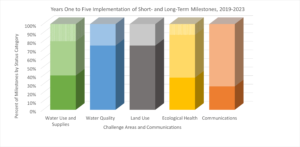
Figure 1. Year one through five implementation progress for short- and long-term milestones, 2019-2023.
Figure 1 shows year one through five implementation progress for short- and long-term milestones, 2019-2023. This figure does not illustrate percent complete by funding or staff time, only by the number of milestones in each status category. Challenge areas are distinguished by color. Status is designated using three shades of that color. The figure legend was developed using Ecological Health as an example. The colors used in Figure 1 correspond to those used in Figure 2 below. While communications is not a challenge area, per se, it is a key component of implementation and is included here for reference.
Select Ongoing Activities
- The One Basin, One Future Collection continues to be updated with products of comprehensive plan implementation.
- Planning is underway for a 2023 Potomac Conference on the topic of climate change, scheduled for September 21, 2023 in Lorton, Virginia.
- ICPRB staff continued to provide methodology development, field response, and watershed planning for Harmful Algal Blooms in the Potomac basin.
- ICPRB continues to meet with state and local stakeholders, identify and fill in data needs, and conduct river user outreach in the North Branch Potomac River region to optimize the multiple uses of the watershed.
- Work is ongoing on acquiring supplemental storage for the Washington, DC, metropolitan area regional water supply system, with a recent notable success: authorization of a USACE feasibility study on a secondary regional water supply in the Water Resources Development Act of 2022, passed by Congress and signed by the President in December 2022.
- ICPRB staff are meeting regularly with staff from the USACE’s Baltimore District Office on potential changes to Jennings Randolph Reservoir operations, which was identified as an alternative which could improve the reliability of the Washington, DC, metropolitan area water supply system (Alternative 8). ICPRB staff finalized a proposal to increase the minimum flow at Luke, Maryland, during drought, documenting benefits based on simulations with PRRISM v3.11, and model verification and potential model updates based on recent changes to USACE reservoir release practices are now under discussion.
-
Updates to improve the contents and usability of the Potomac Water Quality Data Inventory are continuing with assistance from ICPRB’s 2023 intern cohort.
- Focused communications activities included frequent social media posts, and targeted presentations.
Figure 2 shows implementation status by milestone and challenge area. Detailed descriptions of each milestone can be found in the comprehensive plan for each challenge area. While communications is not a challenge area, per se, it is a key component of implementation and is included here for reference. Colors used in this figure correspond to colors used in Figure 1 above. The darker the shade, the closer a milestone is to being complete.
Previous Progress Reports
Year Four
The first four years of implementation of the Potomac Basin Comprehensive Water Resources Plan resulted in the successful completion of approximately thirty-four percent of the planning milestones, continuation of another forty-six percent of the milestones whose implementation is perpetually ongoing, and continuing efforts to address the remaining twenty percent of the planning milestones.
The highlights listed below provide a general overview of the plan’s implementation status (Figure 1), describe select ongoing activities, and give a more detailed picture of implementation status by individual milestone (Figure 2).
Click here for a PDF version of the Four Year Progress.
Highlights
- A One Basin, One Future Collection of comprehensive plan products was designed and made available online. The interface includes new interactive mapping products of ICPRB’s 2018 impervious cover study and ICPRB’s 2020 land prioritization tool among other products.
- A spreadsheet inventory and an associated pamphlet were developed on Potomac basin entities with a role in sustainable water resources management. This effort addresses part of the plan’s overarching recommendation described in Section 3.2.1.A.
- ICPRB continued a webinar series for information sharing between land use decision-makers in the basin. Events were held on January 21 and May 20, 2022. Recordings are available on ICPRB’s Comprehensive Plan YouTube page.
- ICPRB performed a survey and report on Tropical Storm Ida’s impact on a toxic algal bloom in the Shenandoah River in September 2021.
- ICPRB staff prepared a report, supplemental materials, and a video on Potomac River Water Quality at Great Falls: 1940-2019.
- “Baseline” data with which to measure change in stream macroinvertebrate health in the Chesapeake watershed, including the Potomac were added to the online Chesapeake Bay Program database, including metadata and R-scripts.
- ICPRB’s Aquatic Life webpages were updated and expanded to promote communication, engagement, and information sharing.
- ICPRB signed on to the 2022 Interstate Council on Water Policy Senate and House streamgage letters.
- ICPRB conducted the Potomac River Environmental Flows Workshop on May 5 and 17, 2022, and will complete a summary report by the end of September, 2022.
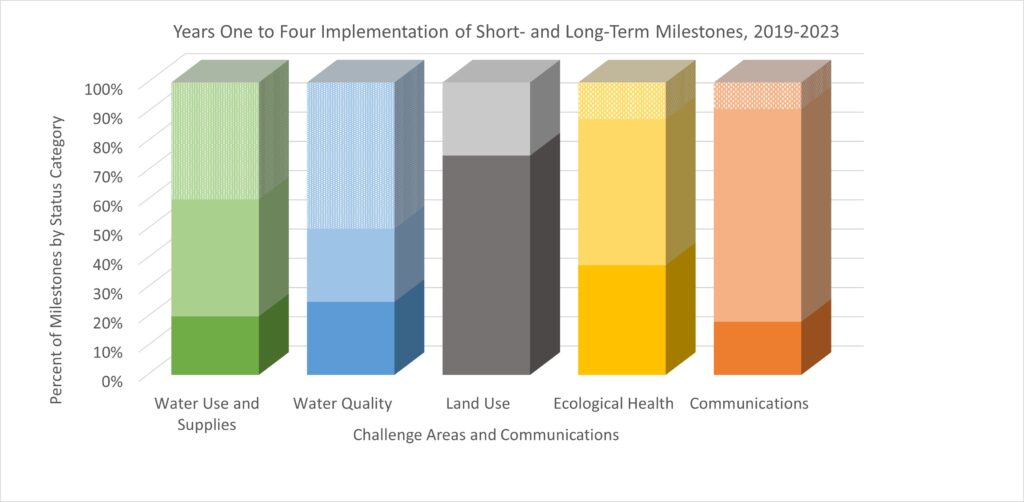
Figure 1. Year one through four implementation progress for short- and long-term milestones, 2019-2023.
See Figure 1 for years 1-4 implementation progress for short- and long-term milestones, 2019-2023. This figure does not illustrate percent complete by funding or staff time, only by the number of milestones in each status category. Challenge areas are distinguished by color. Status is designated using three shades of that color. The figure legend was developed using Ecological Health as an example. The colors used in Figure 1 correspond to those used in Figure 2. While communications is not a challenge area, per se, it is a key component of implementation and is included here for reference.
Select Ongoing Activities
- The Potomac Data Inventory and Mapping Exploration (DIME) initiative is being implemented as a “back-end” and a “front-end”. The “back-end” is a technical, internally facing product for organizing and accessing data and information. The “front-end” includes resources for disseminating finished information, as in the One Basin, One Future Collection.
- Efforts are underway to quantify state reported, basin-wide water uses, demands, and consumptive demands. This effort will complement the completed unreported water uses project to provide a comprehensive look at water uses in the basin.
- The biannual land use webinar series will continue to promote information sharing amongst land use decision-makers in the basin.
- Building on discussions at the 2020 Virtual Event Series, staff are compiling and describing environmental metrics to use in 2023 to evaluate the environmental impact of the plan’s implementation.
- A supplemental effort is underway to respond to recommendations and identified data gaps from the Planning Assistance to States Jennings Randolph Lake Scoping Study Phase II Report and the ICPRB technical report on the Influence of Jennings Randolph Lake and Dam Operations on River Flow and Water Quality in the North Branch Potomac River.
- ICPRB continues to meet with state and local stakeholders, identify and fill in data needs, and conduct river user outreach in the North Branch Potomac River region to optimize the multiple uses of the watershed.
- ICPRB convened the Potomac River Low Flow Allocation Agreement Work Group with a kickoff meeting on March 25, 2022, and work is ongoing to achieve consensus on updates to the original 1978 regional water supply agreement.
- Work is ongoing on acquiring supplemental storage for the Washington, DC, metropolitan area regional water supply system, with two notable successes in 2022: ICPRB’s 7001 proposal was incorporated into the USACE’s 2022 Report to Congress on Future Water Resources Development, and due to the efforts of Congresswomen Norton, the House version of the 2022 Water Resources and Development Act includes a request for a feasibility study on a secondary water source for the region.
- ICPRB staff are meeting regularly with staff from the USACE’s Baltimore District Office on potential changes to Jennings Randolph Reservoir operations, which was identified as an alternative which could improve the reliability of the Washington, DC, metropolitan area water supply system. The benefits of raising the minimum flow at Luke, Maryland, during drought has been modeled and is now under discussion.
-
Updates to improve the contents and usability of the Potomac Water Quality Data Inventory are underway.
- Focused communications activities included press releases, frequent social media posts, and targeted presentations.
See Figure 2 for the implementation status by milestone and challenge area. Detailed descriptions of each milestone can be found in the comprehensive plan for each challenge area. While communications is not a challenge area, per se, it is a key component of implementation and is included here for reference. Colors used in this figure correspond to colors used in Figure 1. The darker the shade, the closer a milestone is to being complete.
Year Three
The comprehensive plan added precision to its use as a tool to guide sustainable water resources policies and actions by documenting the Unreported Water Use in the basin. Use of water for irrigation, industrial use, and drinking that does not fall under reporting requirements is small but significant, and is important in assessments of the amount of sustainable water available for use.
Click here for a PDF version of the Third Year Progress.
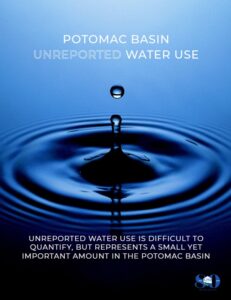 |
Highlights
-
A pamphlet was published on unreported water uses in the basin that includes estimates by HUC-8 for the irrigation, livestock, unconventional oil and gas, thermoelectric, self-supplied domestic, aquaculture, and mining sectors.
- ICPRB initiated a webinar series for information sharing between land use decision-makers in the basin. The kickoff event held on May 7, 2021.
- ICPRB hosted a Virtual Event Series in August and September 2021 to identify opportunities to enhance implementation and evaluate success of the Potomac Basin Comprehensive Water Resources Plan.
- The ICPRB CO-OP 2020 demand study was completed.
- ICPRB’s CO-OP Section and Loudoun Water are completing a joint project, with the assistance of the contractor, Hazen & Sawyer, to update the Potomac OASIS model for use as a collaborative tool to explore the benefits of cooperative operation of Milestone Reservoir.
- ICPRB signed on to the 2021 Interstate Council on Water Policy streamgage letter.
Select Ongoing Activities
- The Potomac Data Inventory and Mapping Exploration (DIME) initiative is in full swing to make Potomac data sets readily accessed, related, and explored.
- Efforts are underway to quantify state reported, basin-wide water uses, demands, and consumptive demands. This effort will complement the completed unreported water uses project to provide a comprehensive look at water uses in the basin.
- The biannual land use webinar series, initiated on May 7, 2021, will continue to promote information sharing amongst land use decision-makers in the basin.
- Building on discussions at the 2020 Virtual Event Series, staff are compiling and describing environmental metrics to use in 2023 to evaluate the environmental impact of the plan’s implementation.
- Ongoing research in the Cacapon River continues to try to identify the link between non-point nutrient sources and localized algal blooms in the region. Most recently, ICPRB has started investigating the role ground water as a vector of nutrient transport in this region.
- ICPRB continues to meet with state and local stakeholders, identify and fill in data needs, and conduct river user outreach in the North Branch Potomac River region to optimize the multiple uses of the watershed.
- Focused communications activities included press releases, frequent social media posts, and targeted presentations.
References
USACOE and ICPRB. 2020. Planning Assistance to States: Jennings Randolph Lake Scoping Study Phase II Report. U.S. Army Corps of Engineers, Baltimore District, Maryland.
Year Two
The first two years of implementation of the Potomac Basin Comprehensive Water Resources Plan resulted in the successful completion of 20 percent of the planning milestones, implementation of another 40 percent of the milestones whose activities will be perpetually ongoing, and continuing efforts to address another 32 percent of the planning milestones.
Click here for a PDF version of the Second Year Progress.
Highlights
- The Potomac Basin Comprehensive Water Resources Plan Event Series, an overarching recommendation of the comprehensive plan, was planned. The event series is slated to include a 2.5 day stakeholder process with topics covering the full range of challenges described in the plan.
- Unreported water use estimates by HUC-8 and county were completed for the irrigation, livestock, unconventional oil and gas, thermoelectric, self-supplied domestic, aquaculture, and mining sectors.
- The manuscript Integrated Sustainable Water Resources Management and Land Use Decision-Making was published in the Journal of Water in August 2020.
- Jennings Randolph Lake Water Control Plan Scoping Study, Phase 2 was completed (USACOE and ICPRB, 2020).
- The ICPRB signed on to the 2020 Interstate Council on Water Policy streamgage letters.
Select Ongoing Activities
- Execution of the Potomac Basin Comprehensive Water Resources Plan Event Series occurred in August and September 2012, event follow-up is underway.
- The Cacapon River filamentous algae study is ongoing with expected completion at the end of fiscal year 2020.
- The Potomac Data Inventory and Mapping Exploration (DIME) initiative is in full swing to make Potomac data sets readily accessed, related, and explored.
- The CO-OP 2020 demand study is under final review.
- A scope of work has been developed for a study on basin-wide water uses, demands, and consumptive demands and initial efforts of the study are underway.
- Focused communications activities included press releases, frequent social media posts, and targeted presentations.
Year One
The following highlights are from the the full Year One Report.
- The ICPRB signed on to the 2019 Interstate Council on Water Policy streamgage letter.
- The LFAA review was completed in February 2018.
- An online precipitation map was developed to assist basin stakeholders in sharing information during droughts.
- An R-program was developed to calculate the Chesapeake Basin-wide Index of Biotic Integrity for stream
macroinvertebrates (Chessie BIBI). The index measures biological status and responses to restoration efforts. - The 2008 baseline for the Chesapeake watershed to measure change in stream macroinvertebrate health was
completed. - The manuscript titled Streamflow Alteration from Impervious Cover: Are All Watersheds Created Equal? was
published in the Journal of the American Water Resources Association in December 2018. - The scope of work is complete for a study on basin-wide water uses, demands, and consumptive demands.
- Focused communications activities included press releases, frequent social media posts, and targeted presentations

